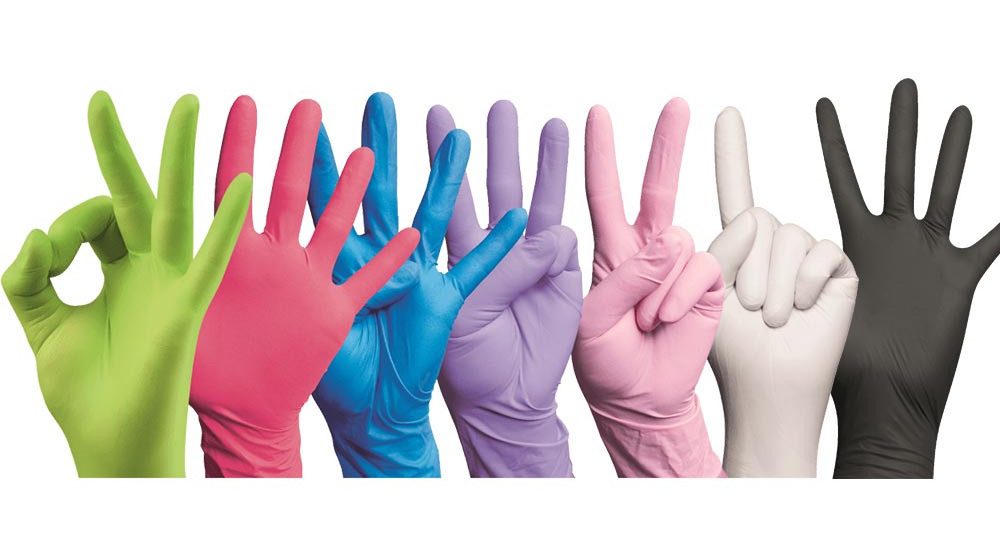- Saturday June 6th, 2020
- Posted by: Costas Halambalakis
- Category: blog

Doctors, nurses, dentists, and other health professionals use disposable gloves during their work. Gloves protect hands and reduce the possibility of transmitting microorganisms. There is a wide variety of types of examination, surgical, and protective disposable gloves to meet the needs of each user.
Examination or surgical gloves?
Examination gloves are primarily used to support non-invasive physical examination, helping to prevent infection between caregivers and patients. They are made of different polymers such as latex, nitrile (nitrile rubber), vinyl (polyvinyl chloride), and polyethylene (PE), and can be sterile, non-sterile, powdered, or powder-free.
Surgical gloves are sterile and are mainly used during surgical procedures to prevent possible transmission of diseases and meet higher levels of quality standards and controls. They are available in precise sizes for greater flexibility and precision of movement (sizes 6 to 9).
Disposable gloves with or without powder?
In powdered disposable gloves, the powder helps to make the application on the hand easier. But there is a possibility that the powder may cause irritation if the user has skin sensitivity. For this reason, powder-free disposable gloves are now more commonly used in healthcare services.
Sterile disposable or non-sterile gloves?
Sterile gloves are commonly used for surgical procedures and in particular when coming into contact with patients who have open wounds, traumas, etc. Mostly, however, non-sterile gloves are preferred.
What types of disposable gloves are there?
- Latex gloves
- Nitrile gloves
- Vinyl gloves
- PE (Polyethylene) gloves
Disposable latex gloves protect the user from blood-borne diseases and various other harmful substances (chemical and body fluids). They are elastic and easily adapted to the hand, provide a high sense of touch, and are durable and flexible. But one of the main disadvantages of disposable latex gloves is that they can cause allergies and skin reactions, itching, irritation, or even severe allergic reaction.
Disposable nitrile gloves are made of inorganic synthetic materials. This makes them ideal for use by people with latex allergies (latex free). They provide high protection from unwanted substances and are more resistant to oils, solvents, and chemicals. Disposable nitrile gloves are three times more puncture resistant than disposable latex gloves.
Disposable vinyl gloves are made of polyvinyl chloride (PVC) and are latex free. Since disposable vinyl gloves are synthetic and non-biodegradable, they have a longer shelf life and do not easily disintegrate over time. They are comfortable, easy to wear, and have great flexibility.
However, disposable vinyl gloves are less durable than previous types of gloves and offer less tactile sensation when touched.
PE (Polyethylene) grained gloves
PE-grained gloves are mainly used in tasks requiring frequent glove changes (e.g. contact with paints, paints, food, and kitchens). These gloves have a loose fit for easy application and are usually used over other types of gloves.
Does color matter in the choice of gloves?
The color of disposable gloves in many cases helps users know what type of gloves to use. Color coding is also used on double gloves to make it easier for workers to recognize when the outer gloves have been torn when using sharp medical instruments. This prevents the spread of germs and contamination of the user.
Disposable nitrile gloves are available in blue, white, black, pink, and purple, as disposable latex gloves in white and black, disposable vinyl gloves in creamy white, and PE-grained gloves in clear.
Therefore, the selection of the appropriate type of disposable gloves should be based on the needs of the user, any allergies and sensitivities the user may have, and the degree of protection desired.
Tips for the correct use of disposable gloves
- We make sure we wear the right size
- Change gloves as soon as they are damaged/ripped or contaminated
- Clean our hands thoroughly before and after removing them
- Remove them immediately after patient contact
- We carefully dispose of them in the bin as soon as we use them and under no circumstances throw them in a recycling bin
